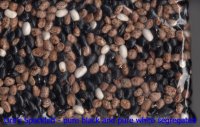Ridgerunner
Garden Master
- Joined
- Mar 20, 2009
- Messages
- 8,241
- Reaction score
- 10,112
- Points
- 397
- Location
- Southeast Louisiana Zone 9A
@Bluejay77 I don't know if I want to even try wrapping my head around that maternal seed coat color being passed down an additional generation. I under sex linked traits but from what you are saying it would not matter if it is a dominant or recessive trait so straightforward sexlinked does not explain it. And I'd expect that seed coat color would not be just one gene pair but several. This is another reason I'm an engineer, not a biologist. Engineering is simple and straightforward.


 This is the first year I've taken detailed notes on the plant's characteristics, so other than what I have from memory, I'm not sure about any other changes in the Ora's Speckled. For the most part the plant looked just like it always had, but I may have missed something. It's my intention to keep better data from now on. I took good notes this year. Last year and this year were the only times it had thrown any difference in seed coat. Could have been crossed up in Bill Best's field, I'm sure. I bought them
This is the first year I've taken detailed notes on the plant's characteristics, so other than what I have from memory, I'm not sure about any other changes in the Ora's Speckled. For the most part the plant looked just like it always had, but I may have missed something. It's my intention to keep better data from now on. I took good notes this year. Last year and this year were the only times it had thrown any difference in seed coat. Could have been crossed up in Bill Best's field, I'm sure. I bought them